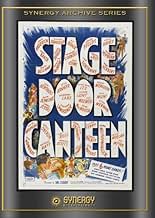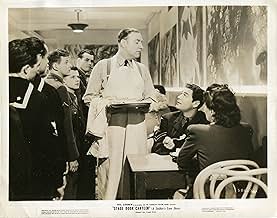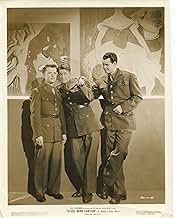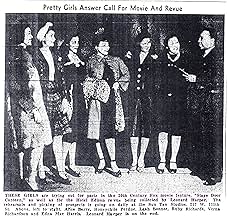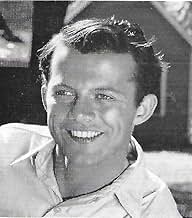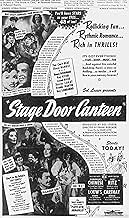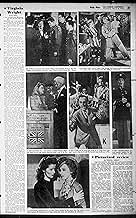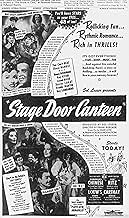Adicionar um enredo no seu idiomaA young soldier arrives in NYC and, before heading overseas to WWII, visits Stage Door Canteen, where famous actresses and entertainers volunteer to entertain soldiers.A young soldier arrives in NYC and, before heading overseas to WWII, visits Stage Door Canteen, where famous actresses and entertainers volunteer to entertain soldiers.A young soldier arrives in NYC and, before heading overseas to WWII, visits Stage Door Canteen, where famous actresses and entertainers volunteer to entertain soldiers.
- Indicado a 2 Oscars
- 1 vitória e 2 indicações no total
Avaliações em destaque
No reason it can't be enjoyed though. Skip the slight plot involving the servicemen who are patronizing the Stage Door Canteen who hook up with the hostesses there. Concentrate on the number of stars in the film, each doing some bit of business for themselves.
Though a number of film stars are here, the film concentrates on stars of the Broadway stage. Katherine Cornell makes her one and only appearance in a film, in fact my favorite part of Stage Door Canteen is her impromptu reading from Romeo and Juliet with bashful GI Lon McCallister who played Romeo in high school. Alfred Lunt and Lynne Fontanne are here also. The Lunts later did some televised plays and we have some kinescope version of them. They eschewed the screen though, so even a bit of footage of them doing kitchen police at the Canteen we should be grateful for.
The concert violinist Yehuda Menuhin is also here and it's nice the GIs took time to hear some serious music, a break from the swing bands of the era that are featured like Count Basie, Freddy Martin, Benny Goodman, and Kay Kyser.
Director Frank Borzage was known for doing films of tender romances and the nominal leads William Terry and Cheryl Walker were little heard from again. Still they do their best to provide the note of poignancy for the serviceman enjoying time with the stars before going to war.
Funniest unintentional moment occurs when Franklin Pangborn and Johnny Weissmuller are on the serving line. Pangborn who was very close to being an out gay actor at the time is looking admiringly at Tarzan and engages in a little banter with Weissmuller. Tarzan decides things are too hot in the kitchen and removes his shirt. I thought Pangborn was going to faint on the spot.
I'm a sucker for these all star extravaganzas, I'll never give a bad review to one of them. Stage Door Canteen provides a glimpse of a bygone era, not likely to return.
In fact, what comes across in the film is the easy camaraderie all the young men shared with people that otherwise they had never met in their ordinary lives. Meeting the likes of Tallulah Bankhead, a woman larger than life, was almost impossible for most of the people going to war.
Some of the best actors of that era are seen doing "supporting roles" in the film. Katherine Cornell, Paul Muni, Katherine Hepburn, Alfred Lunt, Lynn Fontaine, Ina Claire, Ray Bolger, Helen Hayes, are seen interacting with the GIs and as they give them hope and courage about an uncertain future of their lives.
The film is good to watch some of these long gone theater stars in a nostalgic look at our past.
In that sense, the film succeeds; I was actually rather moved by the final words each boy left for his girl at the end of the film. That doesn't mean the film isn't a little saccharine though; it *has* to be--it was meant to be a morale booster during the 1940s (including, as it does, songs about shooting down Japanese planes and marching into Berlin). It rides on the strong wave of American patriotism at the time, reflecting and hoping to add to it, and even hints at an internationalism unheard of these days (the crowd cheers for Russian soldiers and carries Chinese pilots on their shoulders in tribute to their bravery). If you strip it of these time-bound scenes, however, the message and the courage remains, which is what makes STAGE DOOR CANTEEN still a film that one can enjoyably sit through not just for the glamorous star cameos. It's sweet when California keeps trying to kiss Jean and missing out (including an incredibly frustrating final attempt when someone cuts in on them when they're dancing!), and you feel just as dejected as Eileen must when she realises that Dakota *isn't* coming back this time. (Let us, for now, leave aside the fact that I can't seem to find a redeeming quality in Eileen beyond the fact that she's willing to break the canteen rules to make it up to Dakota for being mean to him at first.)
The big-name entertainment in STAGE DOOR CANTEEN really can't be faulted: there are appearances by the orchestras of Benny Goodman, Xavier Cugat and Count Basie (to name just a few!); cameos by Merle Oberon, Katharine Cornell and Alan Mowbray; and a pretty literal striptease that ends way too soon for the boys' liking by Gypsy Rose Lee. My favourite numbers would be 'We Mustn't Say Goodbye' and 'Don't Worry Island', alongside Yehudi Menuhin's beautiful rendition of 'Ave Maria' (unfortunately given under some quite terrible lighting) and the very funny opening act with Edgar Bergen and Charlie. As, essentially, the final act, Hepburn gives her few words great weight and is as striking as ever with her five minutes (tops!) of screen time.
All in all, STAGE DOOR CANTEEN is great fun to watch. It'd be even better fun if one knew all of the people making cameos in it--I could only half-guess at most of them, and I'm sure I missed many many others. A sweet, patriotic film made with a very definite purpose, and if you make allowances for that purpose, it's easy to accept the overdoing of the message, and appreciate the film for what it is... good, clean entertainment!
Você sabia?
- CuriosidadesThe real Stage Door Canteen at 216 W. 44th St., Times Square, was unable to be used for filming, as it was still an operating nightclub during World War II. As such, for this movie, it was re-created at R.K.O. Radio Pictures studios in Culver City, California.
- Citações
Katharine Hepburn: He knows what he's fighting for. He's fighting for the kind of world in which you and he can live together in happiness and peace and love. Don't ever think about quitting. Don't ever stop for a minute... working, fighting,praying until we've got that kind of a world. For you, for him, for your children... for the whole human race. Days without end. Amen.
- Cenas durante ou pós-créditosAll rights granted by the American Theater Wing which gratefully acknowledges and credits the producers, stars and members of all the theatrical unions, guilds, crafts and associations for their participation in the creation and continuance of the original Stage Door Canteen.
- Versões alternativasThere are two versions of this film --- one that runs two hours and twelve minutes, and a shorter television version, which runs one hour and thirty-three minutes (93 minutes), which is the most common one available.
- ConexõesFeatured in Gotta Dance, Gotta Sing (1982)
- Trilhas sonorasThe Girl I Love to Leave Behind
(1943)
Music by Richard Rodgers
Lyrics by Lorenz Hart
Sung and Danced by Ray Bolger (uncredited)
Reprised as dance music near the end
Principais escolhas
Detalhes
- Data de lançamento
- País de origem
- Idiomas
- Também conhecido como
- Stage Door Canteen
- Locações de filme
- Empresa de produção
- Consulte mais créditos da empresa na IMDbPro
- Tempo de duração2 horas 12 minutos
- Cor
- Proporção
- 1.37 : 1
Contribua para esta página


